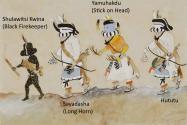
Photograph by Addison Doty. Copyright 2009 School for Advanced Research.
"Procession"
Date: before 1934
Artist or Maker: Alonzo Histito (Lunsi) (1903 - 1987)
Dimensions:
30.5 × 44.4 cm (12 × 17 1/2 in.)
Medium: paper: wove | paint, gouache | pencil
Credit Line: Obtained for permanent colllection in 1934 from an unknown donor.
Place Made:
Zuni Pueblo, McKinley County, New Mexico, Southwest, United States, North America
Object Number: IAF.P79
Not on view
Tribal Collection Review RemarksJim Enote and Octavius Seowtewa during collection review visit June 10 and 11, 2009 (Events Record “Collection Review: Zuni Tribe, Review 2”): This painting depicts a Sayadasha (Long Horn) dance group with Shulawitsi Kwina (Black Firekeeper) (figure on far left). In this painting, the dancers to the right of Shulawitsi Kwina, from right to left, are Sayadasha (Long Horn), then Yamuhakdu (Stick on Head), and then Hututu. There should be one more Yamuhakdu, so this is not a complete representation of the dance group. The Sayadasha dance group starts the Shalako ceremony. They come in before the Shalako and are the first ones to leave the next day. Shulawitsi Kwina must be from the Badger Clan and is always represented by a boy, not a man. Badgers are considered keepers of the fire. Shulawitsi Kwina starts the fire for the beginning of the Shalako ceremony. (There is a White Firekeeper, Shulawitsi Kohana, who starts fires for other ceremonies.) He is shown here with a cedar bark bundle in his right hand that has a smoldering ember at the top. The cedar bundle is tied with yucca. He wears a fawn skin pouch tied around his upper body like a bandolier bag. Shulawitsi Kwina dancers are painted with multi-colored "polka dots" over black body paint. Each of the colors represents one of the sacred directions. The colors are as follows: yellow represents north, blue is west, red is south, and white is east. Black represents below or bottom, while above or top is represented by multi colors.
In Collection(s)
The Indian Arts Research Center, in collaboration with Native American community scholars, strives to present accurate collections records. Records may be updated as new information becomes available and is reviewed with the Native American community having cultural affinity to particular items. Please write to iarc@sarsf.org if you have questions or concerns related to the documentation.


